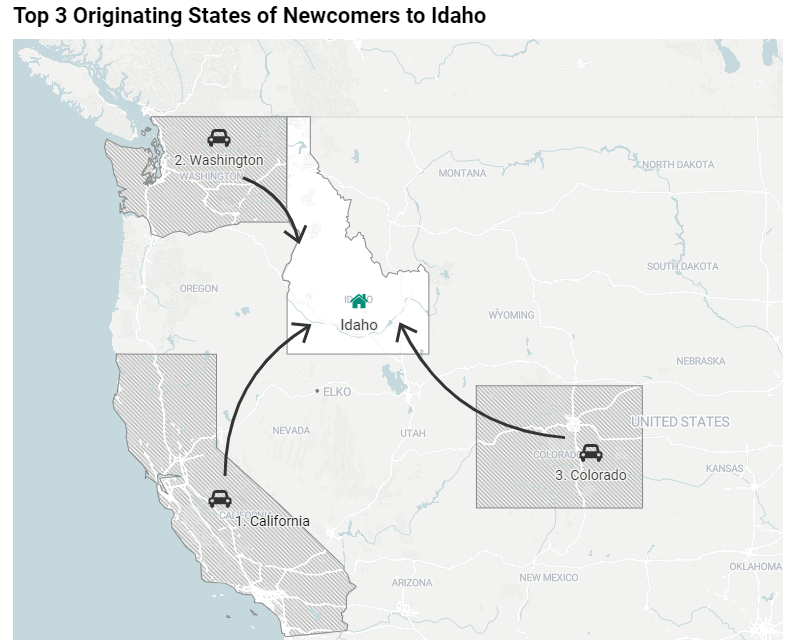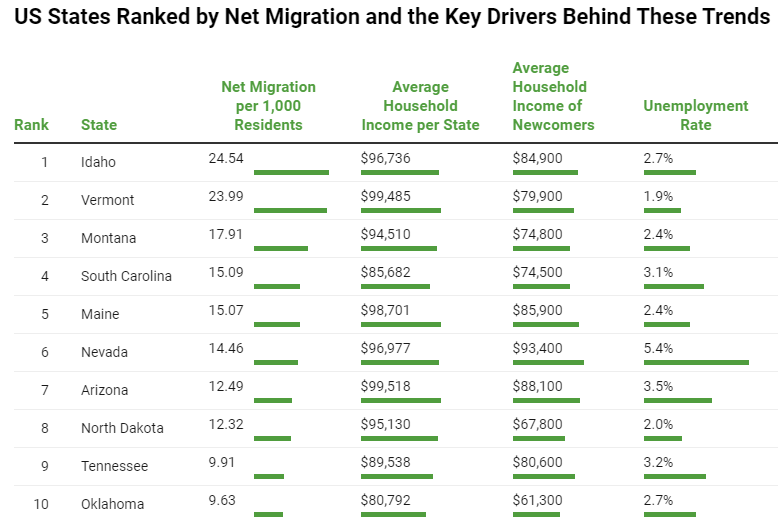Although moving patterns have shifted significantly in recent years, migration rates are down overall, and state-to-state relocation has taken off.
According to a new StorageCafe report, both 2021 and 2022 witnessed increased interstate moving activity compared to the rest of the decade. Research showed that roughly 7.9 million people moved to another state in 2021, and set a record with 8.2 million interstate movers in 2022.
While this trend aligns with historical patterns favoring the Sunbelt region in migration preferences, it's significantly influenced by remote work and an increased demand for more space in the post-pandemic era. U.S. Census data shows a trend towards buying larger homes, particularly in the Southern states where homes sold recently had more square footage compared to those sold in previous years. Overall, the search for more space combined with various economic factors is driving a notable surge in popularity among less-populated states.
"The increased inclination toward remote work has become a significant factor in shaping current housing preferences. On the one hand, you have the aging millennials who are in prime homebuying years and seek more relaxed surroundings. For those spending more time at home, amenities such as a dedicated home office and a larger yard are increasingly desirable, which oftentimes means relocating farther away from busy urban hotspots."
In StorageCafe's report, experts analyze which states people are moving to and what the primary drivers are that motivate them to relocate.
Experts also examined several key indicators to uncover the underlying factors driving these recent migration patterns, including demographic data, incomes and unemployment, home prices and sizes in both the state of origin and the destination, as well as housing inventory," said Doug Ressler, Business Intelligence Manager at Yardi Matrix. "Notably, Western and Southern states are competing vigorously to establish themselves as net migration hotspots, while New England is emerging as a strong contender in the relocation race."
States with the Highest Migration Rates (net migration per 1,000 residents):
- Idaho (24.54)
- Vermont (23.99)
- Montana (17.91)
- South Carolina (15.09)
- Maine (15.07)
- Nevada (14.46)
- Arizona (12.49)
- North Dakota (12.32)
- Tennessee (9.91)
- Oklahoma (9.63)
Western Mountain states get their fair share of newcomers with Idaho first nationally for net migration as share of population.
Among the net migration winners, Interior West states secured four spots on the list, with Idaho, Montana, Nevada, and Arizona making their way into people’s preferences.
"And while more-populated counties are experiencing less net domestic migration, it doesn't necessarily mean that a large increase of people are leaving; rather, we suspect that fewer people are moving to these more densely populated areas," said Emily Skop, PhD, Professor of Geography and Environmental Studies at the University of Colorado.
Idaho saw almost 25 newcomers per 1,000 residents in 2021, according to the latest US Census data—that's five times more newcomers per capita compared to Texas. In fact, Idaho’s population increased by more than 13% over a 5-year interval (from 2016 to 2021), the highest of all US states, with domestic migration one of the main drivers of population growth.
Californians are the most important group of out-of-state movers coming to Idaho. Interestingly, baby boomers comprise around 35% of them, highlighting Idaho as an appealing retirement destination for Californians. Median housing prices in the Golden State are 76% more expensive than in Idaho, which makes this route very financially advantageous for people on the brink of retirement. Not only do they get access to a more peaceful and tranquil lifestyle, but if they sell property in California and buy in Idaho, they will have a nice financial nest egg for the future as well. About 55% of all the Californians moving to Idaho become homeowners in their first year of living there.
Millennials are the age group most often moving to Idaho from other states, foremost from Washington State. Overall, the 22K movers’ households have average earnings of $106K. This is somewhat above the $97K household paychecks in Idaho's, but, as with Californians, they are coming from a state with a much lower unemployment rate of 2.7.
Millennials also form the largest demographic among the several thousands who move every year from Oregon, Utah, and Maine. The average incomes of $89K and $96K that all movers from the first two of these states earn are similar to Idaho’s overall figure. However, the couple of thousand coming from Maine experience an average household income of $145K, which they may need for property prices that are 31% the most expensive.
Montana, another state famous for its beautiful outdoors, ranks third with an influx of 18 newcomers per 1,000 residents. Most of them come from Washington State, California, and Colorado, with Californian baby boomers once again showing a strong appetite for moving to inland states. For example, about 44% of the Californians who relocated to Montana in 2021 are part of the 56-74 age group. Millennials aged 24-38 make up the biggest generational group that chooses Montana from all other top-origin states.
Nevada, ranking 6th overall, registers over 14 newcomers per 1,000 residents, with California the main provider – almost 60K Californians took the route across the desert to Nevada in 2021 alone. The average household that exchanged California for Nevada was made up of four people and they got significantly cheaper homes: A median home in Nevada is 42% less expensive than one in California.
Millennials are the largest group of people relocating to Nevada from four of the top five originating states: California, Arizona, Colorado and Utah. The Silver State is also establishing itself as a premier destination for Generation Xers, particularly from Washington State, from where a remarkable 56% of new arrivals fall into the 40-to-55 age bracket. Moreover, a significant portion of these newcomers are remote workers, accounting for approximately 16% of the people who traded the evergreens of Washington for the sagebrush of Nevada.
Another western hotspot that emerged as a magnet for Gen Xers is Arizona, where the average age of newcomers is 41, placing it third after Florida and Nevada in terms of attracting older residents. Boasting a favorable tax climate, spectacular outdoor scenery and a strong economic landscape, Arizona is steadily drawing in individuals from other states. It landed 7th spot in the ranking of the most popular relocation destinations, with more than 12 new people for every 1,000 residents and a net population gain from incoming migration of over 90K in one year.
New England ranks high on the migration map with Vermont and Maine among the most popular relocation destinations in the U.S.
Vermont ranks second nationally for net migration per capita, with 24 newcomers per 1,000 residents. Vermont is generally attracting a well-educated crowd, as 45% of those coming in hold a bachelor’s degree or higher. Former residents of New York, Massachusetts, New Jersey, and Connecticut make up the bulk of new arrivals. Although Vermont is not an inexpensive destination in terms of cost of living and housing, those from the top originating places are still getting a good deal by relocating: the median home price in Vermont is $210K less expensive compared to the median price in Massachusetts, for example.
Of those moving to Vermont, an appreciable 15% are working from home, a practice that’s even more popular among the younger generation. Gen Zers make up the bulk of those relocating from Connecticut to Vermont, and no less than 36% of all the newcomers taking this route are remote workers, the most among any of the top routes leading to Vermont.
Maine takes the fifth spot among the states with the highest net migration per capita. The state sees 15 newcomers per 1,000 residents, with the average income of those coming in being not far off the average income in the state: $86K vs. $99K. Among those moving to Maine, 45% have a bachelor’s degree or higher. They may work from home, a lifestyle that has become associated with the state and is enjoyed by 17% of the incoming population.
The most common originating states are Massachusetts, New Hampshire, California, and Florida. 63% of the Floridians relocating to Maine are baby boomers, so they are already retired or close to retirement. An impressive 81% of Floridians abandoning warm beaches for cooler ones manage to buy a home during their first year in Maine. Irrespective of the place of origin, roughly 59% of those who move to Maine own a home there. Only 30% of incomers are declared to be renters.
Southern states often bank on inexpensive real estate to attract newcomers.
Two Southern states are among the top 10 with the most newcomers per capita: South Carolina and Tennessee. One thing they have in common is the affordability of their housing markets as well as a burgeoning economy, which attracts movers both from neighboring states and from further afield.
South Carolina, ranking fourth in the list, sees over 15 newcomers per 1,000 residents, with neighboring North Carolina and Georgia standing out as the most common originating states, and Florida, Virginia, and California also contributing. Millennials, now the prime generation in terms of home purchasing, are making up the bulk of those relocating to South Carolina. With a median home value of around $209K, South Carolina is a profitable destination for many. Those coming in from Georgia will pay, on average, $37K less for a home, while those leaving California for South Carolina stand to save an impressive $436K.
Tennessee is the ninth state nationally for net migration as a share of population, with almost 10 newcomers per 1,000 residents. Most of them are moving here from California, Florida, and Georgia, but in addition, Texas and Illinois both sent more than 12,000 people to Tennessee in 2021 alone. All these moving routes, except Illinois, offer newcomers access to a more affordable real estate market compared to their states of origin. Californians who choose Tennessee as their new location are seeing median homes that are almost $413K less expensive—and, in fact, about 65% of the Californians moving here manage to purchase a home within their first year in Tennessee.
North Dakota's appeal has risen with lower costs of living and plenty of room to breathe.
North Dakota, ranking eighth in the country, sees more than 12 newcomers per 1,000 residents. Neighboring Minnesota, followed by Texas and Florida, are the most common originating states for those who choose the Peace Garden State as their new home. The move is financially advantageous for newcomers, as homes in North Dakota are significantly cheaper compared to similar real estate in the originating states. Those relocating from Minnesota to North Dakota get access to a housing market where homes are around 22% less expensive.
Oklahoma rounds out the top 10 of states with the highest net migration as a share of population, with almost 10 newcomers for every 1,000 residents. Texas and California are the states sending the largest waves of people, followed by Kansas. As with other states in the American Heartland, Oklahoma, where the median home price hovers around $167K, represents a very attractive destination for home buyers. Californians have access to homes that are around $478K cheaper than in their originating states, while Texans manage to save an average of $67K in housing costs by relocating to Oklahoma.
Florida ranks 11th with 9.5 newcomers per 1,000 residents and a huge net gain of 208K people in 2021. The state has a pattern of incoming migration that sees people from all around the country making the Sunshine State their new home. The top originating states for newcomers are New York, Georgia, and New Jersey.
Alaska, New York, Illinois and California are losing more than 10 people per every thousand.
While some states are very well equipped to attract new residents, other states are seeing their populations decline at a rapid pace. Alaska and New York are the states where people are leaving the most, with both losing almost 15 people per 1,000 residents, followed by Illinois and California, with more than 10 people leaving per 1,000 residents.
The reasons why these states see negative net migration may vary. In the case of Alaska, the state losing the most people as a share of population, it’s a combination of high living costs and challenging natural conditions. Moving out of California and New York, on the other hand, is mostly fueled by housing costs, combined with an exodus of corporations, who are generally looking for more tax-friendly states. Illinois, which recently lost a seat in the U.S. Congress due to population decline, is battling a combination of a lagging business climate and a high tax burden that persuades people to relocate to other areas of the country. Property tax in Illinois, at 2.2%, is the second highest nationally.
"For years now, domestic migration patterns have been largely predictable, with the Sunbelt and larger urban conglomerates (and their suburbs) increasing the most," said Skop. "But there are many unknowns: certain housing markets will become even more expensive, labor markets will continually shift as a result of global uncertainties, water resources will become more restricted, human-caused natural disasters will become more frequent, and families will experience aging in a way never known before."
To read the full report, including more data, charts, and methodology, click here.

 theMReport.com Your trusted source for mortgage banking news
theMReport.com Your trusted source for mortgage banking news











